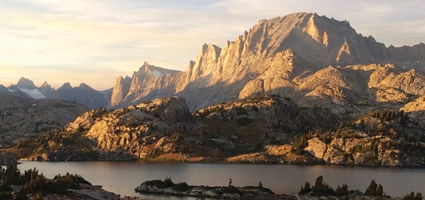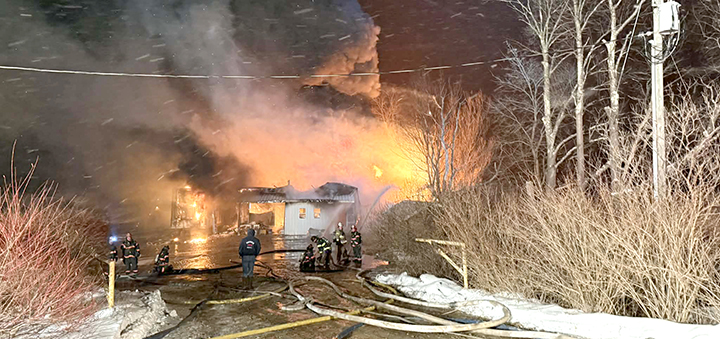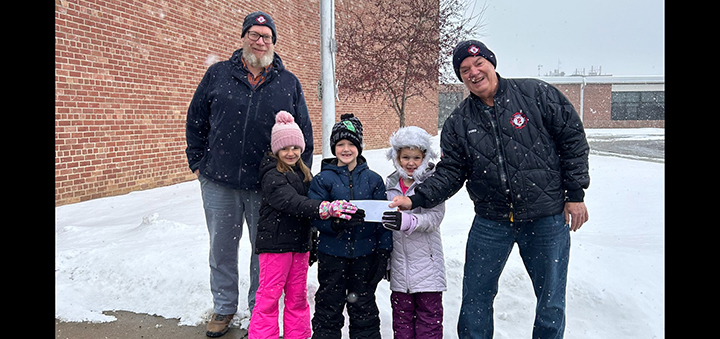Off The Map Week Thirteen: A bridge too far
And then there was one.
All the other western state high-points had left their mark on me. Elbert. Whitney. Kings. Wheeler. Hood. Humphreys. Borah. Rainier. Boundary. Granite. Each had taken something of my body and had given something back to my spirit in exchange. Just one remained – the most remote in the lower 48 states, twenty miles from a trailhead and protected by the largest glaciers in the U.S. Rocky Mountains: Wyoming’s Gannett Peak.
The reason I’d waited until the end of summer to confront this behemoth was because it hid deep inside the Wind River Range, where I’d once been attacked by a nightmarish legion of bloodthirsty mosquitoes - the worst I’d encountered anywhere on the planet. In late August, I knew I’d be safe from the winged fiends. However, I’d made one critical error. I’d waited too long to research the route, discovering too late that I needed to cross a snow bridge to escape the glaciers surrounding Gannett Peak and reach the summit. This late in the summer, the bridge might have already melted away or become so weak that a single footstep could shatter it. If that happened during my climb, I’d fall feet-first into the bergschrund – a deep crevasse formed by the Gooseneck Glacier as it pulls away from the mountain.
For some reason, I could only get mixed secondhand reports about the condition of the snow bridge. I would have to see it for myself and hope I would not be brutally disappointed.
I rented an ice axe and set out from the trailhead on a sun-drenched Saturday morning. Surprisingly, all the other hikers had dogs. So many dogs. I could have built a bridge of dogs to get me off the Gooseneck Glacier… that’s how many there were. At Island Lake I found a hillside free of canines where I could bed for the night and admire the unrivaled scenery. Much of the Wind Rivers looked like a magical kingdom melted and scarred by dragon fire. Towering peaks swept smoothly down to the flanks of rounded foothills, and delicate pools and lakes gave life to the valley floors.
The real origins of the landscape date back a billion years ago, when a vast reservoir of molten rock hardened deep beneath the earth, forming a granite batholith. More recently, this mass of hardened magma was uplifted and eroded by glaciers, creating a stark but beautiful landscape that held forty-one peaks above 13,000 feet.
I started to pitch my tent on a glacier-scoured ridge overlooking the lake. Unfortunately, when I attempted to snap the tent poles together, I discovered that the grooves connecting one shaft to the central hub had eroded away after a decade of steady use. The pole would no longer stay in place, even when secured with a few feet of athletic tape. I set up the tent anyway. It looked sad, deflated and even more claustrophobia-inducing than usual. But it would have to suffice, if just for this one last journey.
The next morning I moved my camp to a field of rubble at the foot of Bonney Pass, then spent the afternoon brooding on the expansive glaciers that waited for me on the other side of the continental divide. I had chosen a more scenic path to reach Gannett Peak than that taken by most hikers, but the price of admission was going to be a steep climb up and over a 12,000-foot ridge-line before dawn. I would then need to descend the Dinwoody Glacier and climb the Gooseneck Glacier before encountering the bergschrund. That moment scared me. I was scared that I would do something stupid to try and complete my quest if the snow bridge was no longer there. Funny… I began this summer cursing the snow that plagued my hikes, and now I was praying for it.
Beneath the headsman’s axe of Mt. Helen, I waited for sundown and grew lonely and anxious. No other hikers came through my campsite bearing news or good wishes. Even the guest appearance of a stray dog would have been comfort to me. Instead, I watched the rudiments of a an alpine cat-and-mouse game, where pikas foraged in the boulder-fields for grass, unaware of the weasel that would occasionally surface among the rocks, black eyes curious, nose twitching, before it plunged out of sight once again.
When my alarm went off in the middle of the night, I switched on my headlamp, padded and taped my injured heel, and crawled out of the tent to face the 1,200-foot slope leading to Bonney Pass. Sunlight at this point was just an unrealized promise. I preferred not to hike in the dark, but if the snow bridge was there, I needed it to remain frozen and solid enough to bear my weight.
Chased by a cold wind, I angled upwards towards the silhouette of a gap between two peaks. The light of my headlamp caused the crystalline boulders to glitter, like I was climbing a hill of black diamonds. I experienced flashbacks from the dark hours spent ascending Mt. Rainier last summer, although this time I was completely alone, with not even the sun for companionship. Where was the sun? I tried to remember that because of the snow bridge, the sun was not my friend today, but it’s hard to keep perspective when you’re feeling isolated and vulnerable.
The dawn trickled in as I gained Bonney Pass and could finally look across the guardian glaciers towards my goal. Gannett Peak simply seemed like the tallest hump in a region of much sharper summits. A prominent ridge would have provided easy access to the top if the Gooseneck Pinnacle hadn’t blocked the route, forcing climbers to brave the adjoining glacier.
I descended Bonney Pass and made the trek across the sprawling Dinwoody Glacier, jumping over snow-filled crevasses until I reached the base of Gannett. The ridge stretched high above me, and on the upper reaches I finally spied the red helmets of another group of climbers. I wasn’t alone. When I caught up to them, they gave me the best news possible: the snow bridge was still intact. It felt like Christmas Day on Gannett Peak.
When the Gooseneck Pinnacle rose up like a wall before us, I strapped on my crampons, readied my ice axe and jumped onto the glacier. To get around the Pinnacle, we would need to ascend a treacherously-steep snowfield before we could regain the ridge again. At the top of the Gooseneck Glacier, I found the base of the snowfield, and sure enough, a bridge still connected the two regions. I saw not one, but two bergschrunds where the glacier had sagged and pulled away from the snowfield. The two cracks had not yet widened enough to meet in the middle, so the way was open.
Leaving the others behind, I raised my ice axe, kicked the sharp tips of my crampons into the snow and hacked my way up the bridge and the vertical terrain that lay beyond. I moved as quickly as possible, for never have I crossed a snowfield that steep while unprotected. If my grip on the mountain failed, the yawning bergschrunds would eagerly swallow me up.
It felt glorious to reach bare rock again. Though exhausted, I failed to be hindered by anything else the ridge-line threw at me. Soon, I was able to throw my pack down onto the summit stones and claim victory over the mountain and over my final objective for the Off The Map series.
The panorama from the highest point in Wyoming was a dramatic change from the artistic contours of Island Lake and Titcomb Basin. There was an air of brutishness about the surrounding peaks. Without the tempering influence of water in the form of streams or lakes, these ice-clad, hyper-masculine peaks acted like mountain men, gruff and utterly formidable.
Eight other climbers braved the snow bridge and arrived after me. Wary of the rising temperatures, I started back down first, but when I reached the slope above the Gooseneck Glacier, I felt a desperate longing to have companions again. Nothing seemed as stable as before. In fact, I watched as a foot-wide block of snow slid down the slope past me and dropped into the bergschrund.
Thirty feet of softened snow tilted at a 55-degree angle separated me from the bridge and the crevasses. I kicked my crampons much deeper into the hillside than before, and after every step I jammed the shaft of the ice axe down through the layers until it was buried to the hilt. Movement was painstakingly slow, but I needed the anchorage that the axe provided; I didn’t trust my crampons to keep me on the mountain anymore. One of the other groups said they were going to use a top-rope for the descent, and I wished I’d waited for them. Pride and impatience might be my undoing.
By the time I worked my way down to the snow bridge, I realized that its potential collapse wasn’t going to be my biggest problem. Instead, the issue was ice. Between the two bergschrunds, the snow wasn’t thick enough to hold my axe anchor in place. Only a thin layer of snow rested atop several feet of ice, and over the last two hours the previously-frozen snow had turned to slush. I had no traction anymore; there was nothing for my crampons to grip into. If I slipped while on the bridge, however, there was a chance I could slide between the bergschrunds, then bounce a hundred feet down to a more level section of the glacier. I’d end up bruised, with the wind knocked out of me, but at least I’d be alive. Then again, I could just as easily fall off the bridge into a crevasse and crack my head on the ice at the bottom. Well… time to throw the dice…
“Hey,” a voice shouted from above me. “Why don’t you try the snow bridge to your left? That’s the way I came up.”
I raised my head towards the top of the snowfield. The only other solo climber on Gannett Peak had caught up to me, apparently, and he was waiting for me to make my move. Looking to the side, I noticed the bridge he was talking about. By no means was it without risk, for it required me to traverse the snowfield directly above the deepest bergschrund, but it seemed a lot less dangerous than my current position.
Thanks to the well-timed advice, I made it off the snowfield alive. I wish it had literally been all downhill from there, but I still had Bonney Pass and twenty miles of uneven ground to cover before I could throw my pack in the jeep and head back to California. That distance, I hoped, would give plenty of time for the vestiges of fear to dissipate from my system so that I could enjoy the Wind Rivers as so many others did – as a place of beauty, contemplation and unbridled wonder.
And dogs. Wouldn’t be the same without the dogs.








Comments